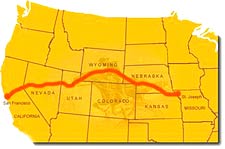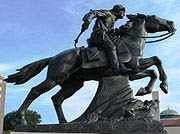
The Pony Express, which brought faster mail service from the East to California, was the brainchild of William Hepburn Russell who was a partner in the West’s largest wagon-freight operation called Russell, Majors and Waddell.
When the Butterfield Overland Mail Operation (St. Louis to San Francisco, a 2,800 mile route that dipped south to El Paso) was suspended in 1861, Russell convinced his partners to develop a new and simpler route from a staging area in St. Joseph, Missouri to San Francisco, using express riders to cover the ground in half the time than the Butterfield route.
There was a $600,000 government contract at stake, so the partners took the bait and issued Russell the credit to establish his Pony Express. Then, out came the ads for young, skinny fearless riders, “Orphans preferred”. Russell hired 80 such men from the hundreds of responses. The riders received a Bible, a pair of Colt revolver and $125 a month to ride at high speed through some of the roughest and most dangerous terrain known to man. One hundred ninety stations in 5 divisions were established, 40 to 100 miles apart depending on the terrain, complete with bunk beds and feeding facilities; relay stations were established every 10 to 20 miles with small shelters, horses and stables.
 On April 3, 1860, the Pony Express was formally begun – a 2,000 mile trek from St. Joseph to San Francisco. The sender had to pay $5 per half-ounce plus the regular 10-cents in U.S. postage.
On April 3, 1860, the Pony Express was formally begun – a 2,000 mile trek from St. Joseph to San Francisco. The sender had to pay $5 per half-ounce plus the regular 10-cents in U.S. postage.
The Pony Express lasted 19 months and became a very expensive operation for Russell and his partners. When the transcontinental telegraph reached California, the Pony Express was discontinued. But it had successfully carried 34,743 pieces of mail.
Its most celebrated rider was William F. Cody.





